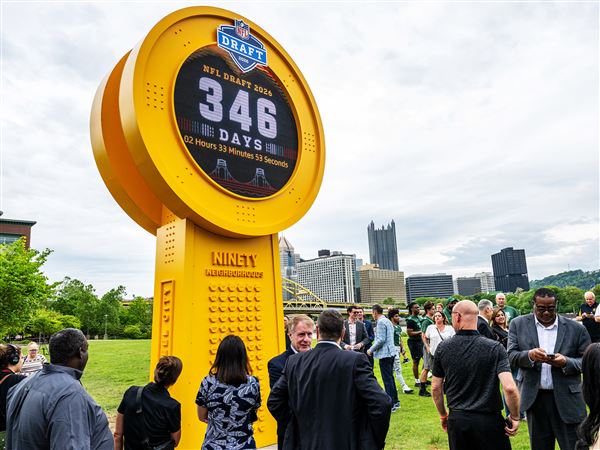Larry McHenry knows to expect the unexpected when watching a total eclipse of the moon.
While videotaping a lunar eclipse in November 2003, he got a little surprise as he watched the colorful view.
 Carnegie Science Center astronomer John Radzilowicz explains what causes a lunar eclipse and why Saturday's is special.
Carnegie Science Center astronomer John Radzilowicz explains what causes a lunar eclipse and why Saturday's is special. Mr. Radzilowicz talks about what to look for in the total eclipse of the moon.
Mr. Radzilowicz talks about what to look for in the total eclipse of the moon. Mr. Radzilowicz remembers a very dark total eclipse from 1991.
Mr. Radzilowicz remembers a very dark total eclipse from 1991. Mr. Radzilowicz says total lunar eclipses are not uncommon.
Mr. Radzilowicz says total lunar eclipses are not uncommon. Larry McHenry, of Baldwin Borough, talks about how he videotaped an airplane flying in front of the eclipsed moon in 2003.
Larry McHenry, of Baldwin Borough, talks about how he videotaped an airplane flying in front of the eclipsed moon in 2003. South Side resident Dave Smith remembers returning home in 1963 from the Army to a very dark total lunar eclipse.
South Side resident Dave Smith remembers returning home in 1963 from the Army to a very dark total lunar eclipse.
 An illustration of how a total eclipse of the moon occurs.
An illustration of how a total eclipse of the moon occurs.
 Watch an animated image taken from Larry McHenry's video of an airplane crossing in front of the total eclipse in 2003.
Watch an animated image taken from Larry McHenry's video of an airplane crossing in front of the total eclipse in 2003.
"Out of the corner of my eye, I saw the airplane lights," said Mr. McHenry, 48, of Baldwin Borough. "And I looked up and saw it was headed straight for the moon. I looked down, and sure enough, right on the monitor, it passed over across the moon ... and after it crossed the moon, you could see the jet contrails. It was just an amazing thing to actually see. I know I jumped up and down a little bit. It's probably a good thing the neighbors weren't out."
Mr. McHenry will be among the many local astronomy enthusiasts who will turn their eyes to the sky Saturday when a total eclipse of the moon will be visible, weather permitting.
The eclipse, however, will be somewhat unusual.
By the time the moon rises in the Pittsburgh area, the total phase of the eclipse will be under way. The moon will be immersed completely in Earth's shadow.
"We have the sun, the Earth and the moon in a straight line with the Earth in between the sun and the moon," said John Radzilowicz, Carnegie Science Center astronomer. "You'll be able to see the eclipsed moon rising at the same time that the sun is setting. So it will be very evident that we've got this straight line so that the Earth's shadow is cast out onto the moon causing the eclipse."
The total phase of the eclipse starts at 5:44 p.m., but the moon doesn't rise in the Pittsburgh area until about 6:09. Greatest eclipse occurs at 6:21, totality just before 6:58 and the partial eclipse ends at 8:11. The nearly invisible penumbral phase ends at 9:24, and the full moon will shine with its usual brilliance.
Observers likely will note that the northern edge of the totally eclipsed moon will be somewhat brighter than the southern part, which is much deeper in the Earth's shadow. But depending on conditions, the moon might be difficult to see.
"Because the Earth has an atmosphere, some sunlight is bent through the atmosphere and actually still hits the moon. So it never completely disappears" during an eclipse, Mr. Radzilowicz said. "But one of the fun things about lunar eclipses is looking to see what color you're going to get. And that really depends on what the conditions are in the atmosphere ... what the cloud cover is like, how much dust is in the atmosphere. And they can go from being very dark, brownish, ruddy-looking to very bright, reddish-orange in color."
Lunar eclipses, like the one Mr. McHenry watched nearly four years ago, can be memorable spectacles.
South Side resident Dave Smith still remembers the moon nearly pulling a disappearing act in 1963.
"I'd gone into the Army and I was away from home for basic training and then advanced infantry training at Fort Gordon, Ga. It was my first leave home after four months in the Army," said Mr. Smith, 61, who was living in Morgantown, W.Va., at the time.
"I remember it was very cold. I had a couple friends from high school stop over at my place and we stayed inside a lot and ran out in the yard to observe it. I don't think we set up any telescopes but I remember the moon turning some fairly deep, copper color ... the moon almost disappeared. It's like, 'Where is it?' It was that dark."
Mr. Radzilowicz recalls a similar eclipse from 1991.
"We had all of the dust in the atmosphere from Mount Pinatubo [in the Philippines] erupting," he said. "And that was the darkest eclipse I have ever seen. That was actually a total eclipse of the moon where, if you did not know where the moon was, you would have had a very tough time finding it in the sky."
Residents who want to watch the eclipse with knowledgeable observers can visit Wagman Observatory in Frazer or Mingo Creek Park Observatory in Nottingham, Washington County. The facilities are operated by the Amateur Astronomers Association of Pittsburgh; visit www.3ap.org for more information. The rooftop observatory at Carnegie Science Center also will be open during the eclipse.
There's a chance we could see an eclipse that will etch itself into our memory, such as the one Mr. Radzilowicz remembers from 16 years ago.
"You could just barely make out the silhouette during totality," he said. "And I've never seen one that dark before or since."
First Published: February 28, 2007, 5:00 a.m.















